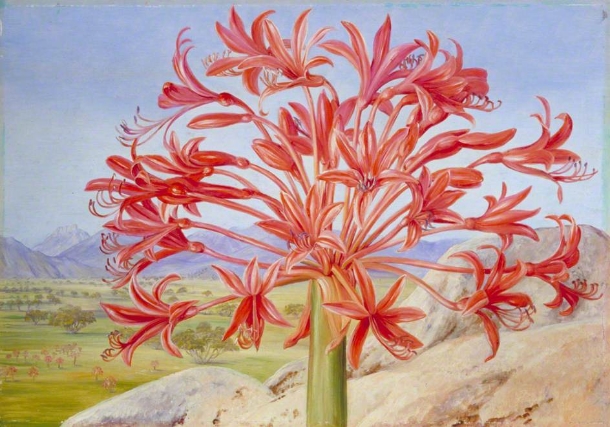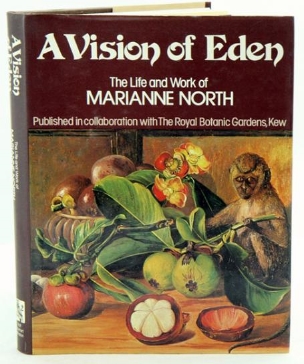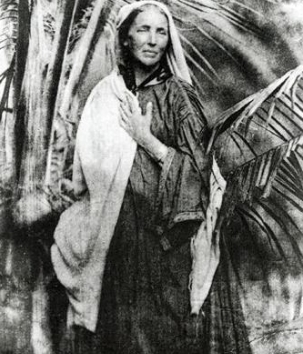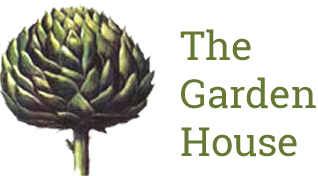Marianne North: plant hunter and botanical artist
Posted:15 March 2015
Following on from Pat Bowen’s fascinating article about ‘plant hunter’ Wendy Campbell-Purdie, Marianne North is another intrepid plant hunter and painter who we thought you would be interested to know more about.
Born in 1830, Marianne North devoted her life to travelling the world and painting plants. The eldest child of Frederick North, Member of Parliament for Hastings, Marianne had shown an interest in painting and writing suitable hobbies for the daughter of an established family but never a thought to making a career of such things.

Although she had no formal training in illustration, and was rather unconventional in her methods, Marianne had a natural artistic talent and was very prolific. She inherited her interest in travelling from her politician father and his connections served her well, providing letters of introduction to ambassadors, viceroys, rajahs, governors and ministers all over the world.
 A woman of means who taught herself how to paint, funded her own expeditions to the far corners of the world to find her subjects, and wrote a biography or two recounting her adventures, may truly be described as unique and that was Marianne North. Her key publication was the beautifully illustrated A Vision of Eden.
A woman of means who taught herself how to paint, funded her own expeditions to the far corners of the world to find her subjects, and wrote a biography or two recounting her adventures, may truly be described as unique and that was Marianne North. Her key publication was the beautifully illustrated A Vision of Eden.
Frederick North travelled throughout Europe and the Middle East, and Marianne would often accompany him. Her first solo journey was in 1871 when she travelled via Jamaica to the United States and Canada. She carried with her suitable letters of introduction, so initially it would seem that her travels were properly accommodated, and this was indeed the case for the most part. Later, however, she found herself trudging through wilderness, scaling cliffs and enduring swarms of insects in the pursuit of her subjects.
Her second solo journey took her to the jungles of Brazil, where she completed over 100 paintings. Then in 1875 she travelled across America on her way to Japan, Sarawak, Java, and Ceylon returning briefly to England. With barely enough time to unpack she was on her way again, this time to India. She remained in India for 15 months and produced a remarkable 200 paintings of mostly plants, but also of the local buildings she liked.
 Upon her return to London she exhibited her work at Conduit Street, where the positive reception and popularity of her work encouraged her to consider displaying her collection at Kew Gardens.
Upon her return to London she exhibited her work at Conduit Street, where the positive reception and popularity of her work encouraged her to consider displaying her collection at Kew Gardens.
She wrote to Sir Joseph Hooker, Kew Gardens illustrious Director, offering to build a gallery if he would agree to display her life’s work in it. The gallery was duly built in a mix of classical and colonial styles. After a visit to Australia and New Zealand, Marianne spent a year arranging her paintings inside the building. It opened to the public in 1882.
In 2008, Kew began restoring the Marianne North Gallery with a £1.8 million Heritage Lottery Fund grant and additional financial support from other donors. Each of Marianne’s 833 paintings, depicting more than 900 species of plants, was also restored and conserved.
Today her paintings provide an important historical record. Some places are still recognisable from her paintings, and, for example, stands of the giant bamboo (Dendrocalamus giganteus) that she painted in 1877 at the Royal Botanic Gardens in Peradeniya, Sri Lanka, can still be seen thriving in Kew Gardens today.
If you are interested in finding out more about plant hunters, there are many books and original materials in the library at Kew and at the RHS Lindley Library near Victoria Station, both of which are accessible to the public on request. The Booth Museum in Brighton has drawers full of examples of herbarium specimens from various 19th and 20th century collectors.
Photo credits: Royal Botanic Gardens, Kew

